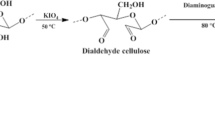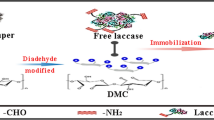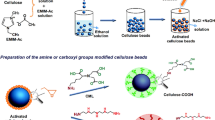Abstract
Cellulose spheres were selected as an economical and biodegradable carrier for urease immobilization. The high crystallinity cellulose spheres (Ces) were crosslinked using citric acid and then oxidized using sodium periodate to produce aldehyde groups on the Ces surface that would bind covalently with the amino groups of urease through a Schiff base reaction. Ces, the obtained dialdehyde cellulose spheres (DACes) and cellulose spheres immobilized by urease (UrCes) were characterized by FTIR, XRD, SEM and TG. The results demonstrated the successful modification of Ces and immobilization of urease, along with the retention of the original spherical morphology and improved thermal stability. As an adsorbent, UrCes had both a greater adsorption capacity for urea and a greater specific selective adsorption than DACes. Urease was respectively immobilized on DACes with 19, 31 and 45% aldehyde contents to obtain UrCes1, UrCes2 and UrCes3. The maximum removal capacities of UrCes1, UrCes2, and UrCes3 for urea were 243.3, 276.2, and 187.6 mg g−1, while only 10.71, 15.08 and 20.50 mg g−1 l-phenylalanine were adsorbed, respectively.








Similar content being viewed by others
References
Balasubramanian A, Ponnuraj K (2010) Crystal structure of the first plant urease from jack bean: 83 years of journey from its first crystal to molecular structure. J Mol Biol 400:274–283
Barbosa O, Ortiz C, Berenguer-Murcia A, Torres R, Rodrigues RC, Fernandez-Lafuente R (2015) Strategies for the one-step immobilization-purification of enzymes as industrial biocatalysts. Biotechnol Adv 33:435–456
Basri SN, Zainuddin N, Hashim K, Yusof NA (2016) Preparation and characterization of irradiated carboxymethyl sago starch-acid hydrogel and its application as metal scavenger in aqueous solution. Carbohydr Polym 138:34–40
Cantone S, Ferrario V, Corici L, Ebert C, Fattor D, Spizzo P, Gardossi L (2013) Efficient immobilisation of industrial biocatalysts: criteria and constraints for the selection of organic polymeric carriers and immobilisation methods. Chem Soc Rev 42:6262–6276
Cheng Y, Lu J, Liu S, Zhao P, Lu G, Chen J (2014) The preparation, characterization and evaluation of regenerated cellulose/collagen composite hydrogel films. Carbohydr Polym 107:57–64
Danial EN, Hamza AH, Mahmoud RH (2015) Characteristics of Immobilized Urease on Grafted Alginate Bead Systems. Braz Arch Biol Technol 58:147–153
Duchemin B, Staiger MP (2009) Treatment of Harakeke fiber for biocomposites. J Appl Polym Sci 112:2710–2715
Fernandez-Lafuente R (2009) Stabilization of multimeric enzymes: strategies to prevent subunit dissociation. Enzyme Microb Technol 45:405–418
Guedidi S et al (2010) Effect of enzyme location on activity and stability of trypsin and urease immobilized on porous membranes by using layer-by-layer self-assembly of polyelectrolyte. J Membr Sci 365:59–67
Guzik U, Hupert-Kocurek K, Wojcieszynska D (2014) Immobilization as a strategy for improving enzyme properties-application to oxidoreductases. Molecules 19:8995–9018
Jesionowski T, Zdarta J, Krajewska B (2014) Enzyme immobilization by adsorption: a review. Adsorption 20:801–821
Jiang X, Yang Z, Peng Y, Han B, Li Z, Li X, Liu W (2016) Preparation, characterization and feasibility study of dialdehyde carboxymethyl cellulose as a novel crosslinking reagent. Carbohydr Polym 137:632–641
Kang H, Liu R, Huang Y (2015) Graft modification of cellulose: methods, properties and applications. Polymer 70:A1–A16
Klemm D, Heublein B, Fink HP, Bohn A (2005) Cellulose: fascinating biopolymer and sustainable raw material. Angew Chem Int Ed Engl 44:3358–3393
Krishna BL, Singh AN, Patra S, Dubey VK (2011) Purification, characterization and immobilization of urease from Momordica charantia seeds. Process Biochem 46:1486–1491
Leppänen K, Andersson S, Torkkeli M, Knaapila M, Kotelnikova N, Serimaa R (2009) Structure of cellulose and microcrystalline cellulose from various wood species, cotton and flax studied by X-ray scattering. Cellulose 16:999–1015
Liang ZP, Feng YQ, Liang ZY, Meng SX (2005) Adsorption of urea nitrogen onto chitosan coated dialdehyde cellulose under biocatalysis of immobilized urease: equilibrium and kinetic. Biochem Eng J 24:65–72
Liu X, Chang PR, Zheng P, Anderson DP, Ma X (2014) Porous cellulose facilitated by ionic liquid [BMIM]Cl: fabrication, characterization, and modification. Cellulose 22:709–715
Luo Z, Fu X (2010) Immobilization of urease on dialdehyde porous starch. Starch—Stärke 62:652–657
Ma X, Liu X, Anderson DP, Chang PR (2015) Modification of porous starch for the adsorption of heavy metal ions from aqueous solution. Food Chem 181:133–139
Ma X, Liu C, Anderson DP, Chang PR (2016) Porous cellulose spheres: preparation, modification and adsorption properties. Chemosphere 165:399–408
Ma X, Lv M, Anderson DP, Chang PR (2017) Natural polysaccharide composites based on modified cellulose spheres and plasticized chitosan matrix. Food Hydrocoll 66:276–285
Mahmoudian S, Wahit MU, Ismail AF, Yussuf AA (2012) Preparation of regenerated cellulose/montmorillonite nanocomposite films via ionic liquids. Carbohydr Polym 88:1251–1257
Martins LR, Rodrigues JA, Adarme OF, Melo TM, Gurgel LV, Gil LF (2017) Optimization of cellulose and sugarcane bagasse oxidation: application for adsorptive removal of crystal violet and auramine-O from aqueous solution. J Colloid Interface Sci 494:223–241
Monier M, El-Sokkary AM (2012) Modification and characterization of cellulosic cotton fibers for efficient immobilization of urease. Int J Biol Macromol 51:18–24
Nikolic T, Milanovic J, Kramar A, Petronijevic Z, Milenkovic L, Kostic M (2014) Preparation of cellulosic fibers with biological activity by immobilization of trypsin on periodate oxidized viscose fibers. Cellulose 21:1369–1380
Nikolic T, Korica M, Milanovic J, Kramar A, Petronijevic Z, Kostic M (2017) TEMPO-oxidized cotton as a substrate for trypsin immobilization: impact of functional groups on proteolytic activity and stability. Cellulose 24:1863–1875
Oladipo AA, Gazi M (2016) Hydroxyl-enhanced magnetic chitosan microbeads for boron adsorption: parameter optimization and selectivity in saline water. React Funct Polym 109:23–32
Pham ML et al (2017) Immobilization of beta-Galactosidases from Lactobacillus on Chitin using a Chitin-binding domain. J Agric Food Chem 65:2965–2976
Pogorilyi RP, Melnyk IV, Zub YL, Seisenbaeva GA, Kessler VG (2016) Enzyme immobilization on a nanoadsorbent for improved stability against heavy metal poisoning. Colloids Surf B Biointerfaces 144:135–142
Prissanaroon-Ouajai W, Sirivat A, Pigram PJ, Brack N (2015) Potentiometric urea biosensor based on a urease-immobilized polypyrrole. Macromol Symp 354:334–339
Qiao C, Chen G, Zhang J, Yao J (2016) Structure and rheological properties of cellulose nanocrystals suspension. Food Hydrocolloids 55:19–25
Sahoo B, Sahu SK, Pramanik P (2011) A novel method for the immobilization of urease on phosphonate grafted iron oxide nanoparticle. J Mol Catal B Enzyme 69:95–102
Soltani Firooz N, Panahi R, Mokhtarani B, Yazdani F (2017) Direct introduction of amine groups into cellulosic paper for covalent immobilization of tyrosinase: support characterization and enzyme properties. Cellulose 24:1407–1416
Spinella S et al (2016) Concurrent cellulose hydrolysis and esterification to prepare a surface-modified cellulose nanocrystal decorated with carboxylic acid moieties. ACS Sustain Chem Eng 4:1538–1550
Sun B, Hou Q, Liu Z, Ni Y (2015) Sodium periodate oxidation of cellulose nanocrystal and its application as a paper wet strength additive. Cellulose 22:1135–1146
Talingtaisong S, Vongsetskul T, Panatdasirisuk W, Tangboriboonrat P (2017) Gauze-reinforced electrospun regenerated cellulose ultrafine fibers for immobilizing bromelain. Cellulose 24:2967–2975
Tao J, Xiong J, Jiao C, Zhang D, Lin H, Chen Y (2017) Cellulose/polymer/silica composite cotton fiber based on a hyperbranch-mesostructure system as versatile adsorbent for water treatment. Carbohydr Polym 166:271–280
Tiwari A, Aryal S, Pilla S, Gong S (2009) An amperometric urea biosensor based on covalently immobilized urease on an electrode made of hyperbranched polyester functionalized gold nanoparticles. Talanta 78:1401–1407
Wang S, Lu A, Zhang L (2016) Recent advances in regenerated cellulose materials. Prog Polym Sci 53:169–206
Wang YF, Wang YG, Ouyang XK, Yang LY (2017) Surface-imprinted magnetic carboxylated cellulose nanocrystals for the highly selective extraction of six fluoroquinolones from egg samples. ACS Appl Mater Interfaces 9:1759–1769
Wu R, He BH, Zhao GL, Qian LY, Li XF (2013) Immobilization of pectinase on oxidized pulp fiber and its application in whitewater treatment. Carbohydr Polym 97:523–529
Yu J, Chang PR, Ma X (2010) The preparation and properties of dialdehyde starch and thermoplastic dialdehyde starch. Carbohydr Polym 79:296–300
Acknowledgments
This research was supported by the National Nature Science Foundation of China (51462009 and 51662011).
Author information
Authors and Affiliations
Corresponding authors
Rights and permissions
About this article
Cite this article
Lv, M., Ma, X., Anderson, D.P. et al. Immobilization of urease onto cellulose spheres for the selective removal of urea. Cellulose 25, 233–243 (2018). https://doi.org/10.1007/s10570-017-1592-3
Received:
Accepted:
Published:
Issue Date:
DOI: https://doi.org/10.1007/s10570-017-1592-3




